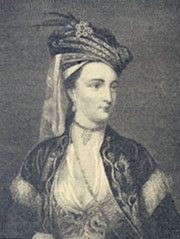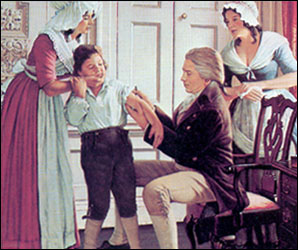Immunization : A Guide towards better health
Principles of vaccination
The principal vaccines
The vaccine calendar
Vaccination of the child
Vaccination of the pregnant woman
Vaccination in the professionnal environment
Vaccination of the traveller
Development, marketing and assumption of responsibility of the vaccines in France
Development of the vaccine policy in France
Evaluation of the vaccination programs in France
Bibliography
Your feedback
 Lady Montagu
Lady Montagu
(1689 - 1762)
 Edward Jenner
Edward Jenner
(1749 - 1823)
 Jenner
inoculating an 8 year old boy with cowpox.
Jenner
inoculating an 8 year old boy with cowpox.
 Louis Pasteur
Louis Pasteur
(1822 - 1895)

History of vaccination
During centuries spent to the effects of the famines and wars, the epidemics came to add their part of suffering and death. They were dreaded and fought against for an immemorial time. They were often allotted to a divine punishment and their origins remained mysterious.
In the 16th century, Fracastore, a doctor of Verona who was interested in syphilis and in the plague, wrote: "the contagion is done by particles which do not fall under the direction".
The idea of protection brought about by an infection
Certain diseases are contagious, i.e. they can be contracted on contact with a sick subject by transmission of the infectious agent. The fact that a first attack by one of these diseases protects the patients against a second attack was taken to be a little vague, sometimes with philosophical or even magic contour: to overcome danger brings safety, perhaps like a test which was extenuated.
It appeared quickly to men on whom the diseases struck only one time that, if the first attacks were well overcome, there would be no more risk to contract it again. However the phenomenon remained full with uncertainty since repetitions were observed, like the cold and flu.
Origins of the Jenner vaccine
Derived from Latin vaccinae, i.e. "of the cow", the word "vaccination" means "to get immune against". It is a term appeared about 1880, used apparently for the first time by Pasteur on the basis of work of englishman Jenner, who immunized patients against the "variola of the cow", and thus of common variola.
Vaccination
was not really
a
breakthrough at that time,
because it was
already
practised in Turkey since immemorial
times. Turkish
people
"vaccinated" against
variola
by taking traces of the moderate
strain
of variola and by inoculating them within
healthy people.
The practice
of immunization,
which was
somewhat risky,
was discovered by the ambassadress from England in
Constantinople, Lady Mary Wortley Montagu. Lady Montagu
introduced this type of immunization in Great Britain, in
1718. Many people immunized themselves against this disease
which spread terror… but some died
with
it. One cannot thus say
that
only Jenner, which practised the first
immunization
on a broad scale vaccination against variola (known as then
"small pox") really discovered the principle of this
therapeutic.
Jenner and Pasteur
Despite the strong movements of hostility, the Jenner vaccination gained ground. In 1800, it was introduced in France by the duke of Rochefoucauld-Liancourt. In 1803, The Royal Jennerian Society was created, which ensured the public free vaccination. The concept of attenuated germ had also meanwhile made its way in the mind of the doctors. It was obvious that one could not inoculate the germs of a disease against which one wanted to immunize, as that had been the case with the variolisation, under penalty of starting this disease itself. Although one was unaware of about all the immunizing mechanisms at that time, the concept of immunity started to cut through a path and one postulated, rightly, that the inoculation of an attenuated germ could help organizations to recognize a germ and to defend against it.
Thus, when Pasteur prepared the first anti-bacterial vaccine directed against anthrax bacteria, it used attenuated germs. To this occasion the scientist paid a cordial homage to Jenner as "one of greatest Englishman". This principle of the attenuation was implemented by Pasteur during his preparation of the vaccine against rabies: the virus injected was the object of one hundred successive intra-cerebral injections of a mixture of infected rabbit spinal cord, and from one animal to another. The vaccine had then only been tested on dogs when, in 1885, one introduced to Pasteur a 9 year old child, Joseph Meister, who had been bitten by a mad dog. Although he was not a doctor, Pasteur accepted the challenge which was imposed to him. So, he tried out the vaccine on the child with a success which everyone knows about. Modern vaccination was born.
Before our era, the Chinese tried themselves to fight variola, while inoculating with healthy people of the broyats of pustules of patients. But it is at the end of last century that vaccination was really understood, with work of Edward Jenner and Louis Pasteur.